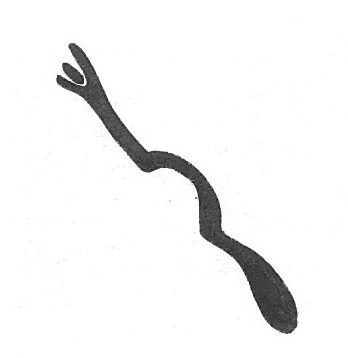by, John J White, III, Beverley H. Moseley, Jr, and Cyclone Covey
Originally published in the Midwestern Epigraphic Society Newsletter, Volume 18, Number 2.
A leading objective of the MES founders was the reporting of new information and interpretations that would lead to a better understanding of Ohio, Ohio River Valley, and Midwestern ancient history. Thus it should come as no surprise that we view the Great Serpent Mound of Adams County, Ohio as an extremely significant artifact left by the higher cultures of ancient Ohio. The serpent Mound could be related to the so-called Mound Builder culture, but the exact interpretation eludes us to date. Corroborative news and interpretation related to our ideas on this subject are thus very exciting.
The figure in the next column is a conceptual replica of the Adams County Serpent, especially with regard to the presence of an egg-shaped object. This serpent is a 160-foot long manmade soil-depression (intaglio excavation) discovered near Lyons, Kansas (central) in 1917 but only investigated archaeologically after 1980 by Clark Mallam of Luther College in Iowa. We learned of the Lyons Serpent via an interpretive study made by Joseph Hickey and Charles Webb of Emporia State University.
Mallam trenched for artifacts with little result. He then made sightings on three nearby earthen mounds called the Quiviran Council Circles. The alignments were so favorable for equinox observation that Mallam concluded that the ovoid object in the Lyons Serpent’s jaws represented the sun. It is claimed that this idea is a common metaphor among many Native American groups! It is suggested that on the longest day of the year, the serpent literally swallowed the sun thereby threatening all life with extinction. But, of course, nothing visual really happens!
Primitive Science 101 is a course that prepares students to tackle this type of interpretation. It has not been offered very often in the Ohio area. As a result, the Great Serpent Mound continues to tell a vague creation story about a Serpent and an Egg. Further, limited dating tests suggest a 1000 CE construction by the Fort Ancient people who were culturally impoverished and had little interest in architecture except for protective structures.
Our Sun God worshiping ancestors were perplexed by the great mystery of the sun’s activities during the night between the sunset and the next sunrise. The old Earth God/Serpent was a perfect Cosmic Serpent/God of the Night who could account for this mystery. He simply swallowed the Sun at sunset, provided a challenge to his survival trip during the night, and released him on the opposite side of the earth at sunrise. Such a concept you recall resembles the Pre-Dynastic Egyptian Sun religion of Ra (Ra/Thoth/Maat) who was engaged by the Serpent Apep each night. This myth had over 4000 years to diffuse to North America!
References
1. C Covey, “Ohio Valley Crucible”, Midwestern Epigraphic Journal 11, 11-23 (1997).
2. JJ White, “Serpent Images on Burrows Cave Artifacts”, Midwestern Epigraphic Newsletter 15(3), 2p (1998); “Ancient Serpents of Southern Illinois”, The Ancient American 4(26), 22-23 (1999).
3.) RC Mallam, “Ideology from the Earth”, Archaeology 35(4), 60-64 (1982).
4.) RC Mallam, “The Serpent: A Prehistoric Life Metaphor in South Central Kansas”, Journal of the Kansas Anthropological Association 5(2), 37-84 (1984).
5.) JV Hickey and CE Webb, “The Lyons Serpent: Speculations on the Indian as Geographer”, The Emporia State Research Studies 33(4), 1-48 (1985), Emporia, KS.
6.) EA Wallis Budge, The Gods of the Egyptians, Dover Publications, Mineola, NY, 1969, 2 Vols. FP 1904.
Note: The image attached is an outline of the Lyons Serpent Effigy of Lyons, Kansas (sketch by BH Moseley after a figure by Hickey and Webb)
Added 10-21-14 https://www.facebook.com/photo.php?fbid=828733593813498&set=gm.505858312850788&type=1&relevant_count=1


